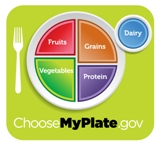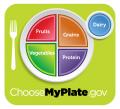 U.S. Dairy Industry Leaders Welcome Revised Approach to Dietary Guidance
U.S. Dairy Industry Leaders Welcome Revised Approach to Dietary Guidance
WASHINGTON, DC – The shape may have shifted from pyramid to plate, but the message remains the same: dairy is an important part of the daily diet, for adults and children alike.
For that reason, the National Milk Producers Federation (NMPF) and other dairy organizations today praised the USDA’s new MyPlate education tool, which provides a clear and visual message that a healthy diet is comprised of a variety of nutrient-rich foods, including low-fat and fat-free milk, cheese, and yogurt.
America’s dairy farmers and processors commended the USDA for including a light blue circle depicting a serving of “Dairy” – milk, cheese, or yogurt – next to the dinner plate to illustrate how to build a healthy eating plan, including a serving of dairy at every meal.
“Dairy foods are rightfully being recognized — from the school house to the White House — as an important part of everyone’s diet,” noted NMPF President and CEO Jerry Kozak. “USDA’s new MyPlate, the simple visual metaphor of a serving of dairy products alongside a plate, says it’s vital to consume three servings of low-fat and fat-free dairy foods every day.”
Other dairy industry leaders similarly applauded the new graphic. “Knowing what we do about dairy’s ability to reduce the risk of conditions like osteoporosis, hypertension, and type 2 diabetes, we think it’s exciting that dairy is highlighted individually,” said Jean Ragalie, R.D., president of National Dairy Council. “The location of dairy on the graphic really helps it stand out as an essential part of a healthy eating plan,” she added.
“Milk provides a unique package of nine essential nutrients and dairy foods are a substantial contributor of many nutrients that are important for good health,” offered Vivien Godfrey, CEO of the Milk Processor Education Program. “We are firm believers in the importance of ‘pouring one more’ serving of dairy, and this tool will be a fresh reminder to all Americans as they sit down at their tables with their families.”
Dairy contributes beyond the glass, as well. A serving of nutrient-rich, low-fat or fat-free milk, cheese, or yogurt has, on average, at least as much protein as an egg. In fact, dairy foods contribute 18 percent of the protein to the American diet. Simple steps, like adding lower fat cheese to a veggie sandwich or topping a baked potato with fat-free plain yogurt can give any meal a nutrient boost.
Americans currently average about 2 daily servings of dairy foods, while USDA’s dietary guidelines encourage 3 daily servings of low-fat or fat-free milk and milk products for adults and children nine years and older. This underscores the importance of a direct, visual metaphor like the MyPlate tool in relaying this guidance to a population being urged to get more nutrients per calorie at every meal.
“We’re delighted that this new education tool makes it clear that milk and other dairy products are important for a nutritious diet,” said Connie Tipton, president and CEO of the International Dairy Foods Association. “It highlights how beneficial a serving of dairy at every meal can be and helps to educate people about dairy’s role on the table and in the American diet.”
The new MyPlate will encourage a variety of dietary patterns that support a healthy lifestyle, and it will make clear that dairy foods are a nutritional fit for most everyone. Whether it’s flavored or lactose-free milk, Greek yogurt or frozen yogurt, or one of the many reduced-fat cheese options available, the dairy industry is committed to providing tasty, healthy and affordable options to help Americans consume essential nutrients that can be hard to get from other foods.
The National Milk Producers Federation, based in Arlington, VA, develops and carries out policies that advance the well being of dairy producers and the cooperatives they own. The members of NMPF’s 31 cooperatives produce the majority of the U.S. milk supply, making NMPF the voice of more than 40,000 dairy producers on Capitol Hill and with government agencies.
National Dairy Council® (NDC) is the nutrition research, education and communications arm of Dairy Management Inc™. On behalf of U.S. dairy farmers, NDC provides science-based nutrition information to, and in collaboration with, a variety of stakeholders committed to fostering a healthier society, including health professionals, educators, school nutrition directors, academia, industry, consumers and media. For more information, visit www.nationaldairycouncil.org.
The Milk Processor Education Program (MilkPEP), Washington, D.C., is funded by the nation’s milk processors, who are committed to increasing fluid milk consumption. The National Fluid Milk Processor Promotion Board, through MilkPEP, runs the National Milk Mustache “got milk?”® Campaign, a multi-faceted campaign designed to educate consumers about the health benefits of milk. For more information, go to http://www.whymilk.com. Deutsch, A Lowe and Partners Company, is the creative agency for the National Milk Mustache “got milk?”® Campaign.
The International Dairy Foods Association (IDFA), Washington, D.C., represents the nation’s dairy manufacturing and marketing industries and their suppliers, with a membership of 550 companies representing a $110-billion a year industry. IDFA is composed of three constituent organizations: the Milk Industry Foundation (MIF), the National Cheese Institute (NCI), and the International Ice Cream Association (IICA). IDFA’s 220 dairy processing members run more than 600 plant operations, and range from large multi-national organizations to single-plant companies. Together they represent more than 85 percent of the milk, cultured products, cheese, and frozen desserts produced and marketed in the United States. For more information, visit www.idfa.org.
1 U.S. Department of Agriculture Center for Nutrition Policy and Promotion. http://www.choosemyplate.gov/
2 U.S. Department of Agriculture, Agricultural Research Service. 2010. USDA National Nutrient Database for Standard Reference, Release 23. Nutrient Data Laboratory Home Page, http://www.ars.usda.gov/ba/bhnrc/ndl
3 Dairy Research InstituteTM, NHANES (2003-2006). Ages 2+ years. Data Source: Centers for Disease Control and Prevention, National Center for Health Statistics, National Health and Nutrition Examination Survey. Hyattsville, MD: U.S. Department of Health and Human Services, Centers for Disease Control and Prevention, [2003-2004; 2005-2006]. [http://www.cdc.gov/nchs/nhanes.htm]
4 U.S. Department of Health and Human Services and U.S. Department of Agriculture. Dietary Guidelines for Americans, 2010. 7th Edition, Washington, DC: U.S Government Printing Office, January 2011.
Senate Bill Includes H-2A Visa Program for Dairy Farms










